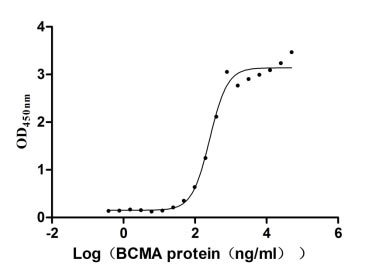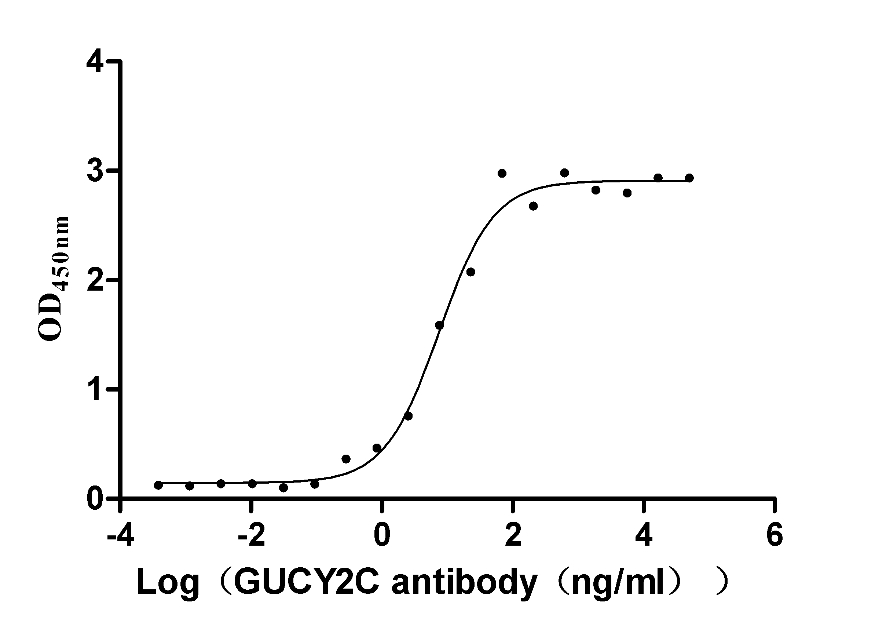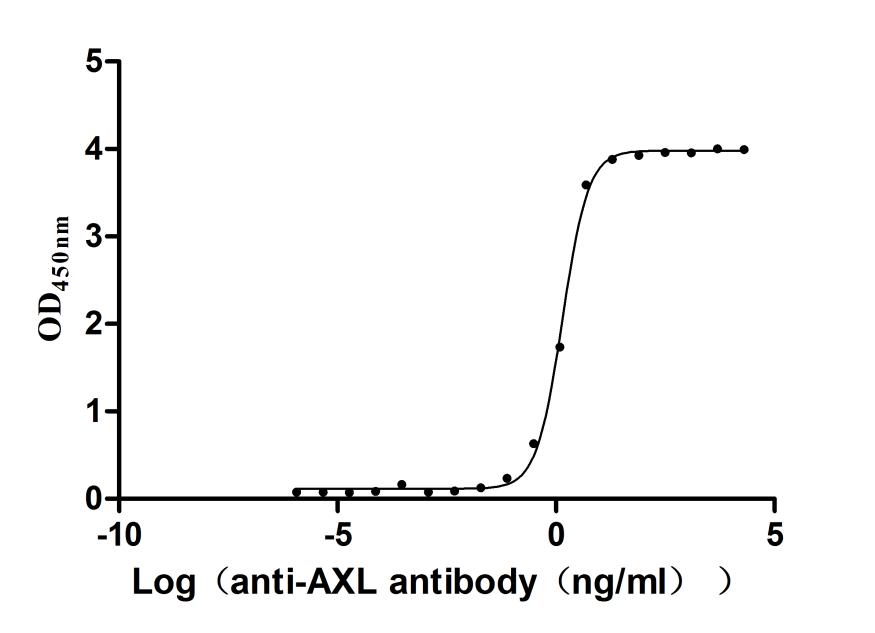Recombinant Mouse Fibroblast growth factor 9 (Fgf9)
-
货号:CSB-YP008638MO
-
规格:
-
来源:Yeast
-
其他:
-
货号:CSB-EP008638MO
-
规格:
-
来源:E.coli
-
其他:
-
货号:CSB-EP008638MO-B
-
规格:
-
来源:E.coli
-
共轭:Avi-tag Biotinylated
E. coli biotin ligase (BirA) is highly specific in covalently attaching biotin to the 15 amino acid AviTag peptide. This recombinant protein was biotinylated in vivo by AviTag-BirA technology, which method is BriA catalyzes amide linkage between the biotin and the specific lysine of the AviTag.
-
其他:
-
货号:CSB-BP008638MO
-
规格:
-
来源:Baculovirus
-
其他:
-
货号:CSB-MP008638MO
-
规格:
-
来源:Mammalian cell
-
其他:
产品详情
-
纯度:>85% (SDS-PAGE)
-
基因名:
-
Uniprot No.:
-
别名:Fgf9; Fgf-9Fibroblast growth factor 9; FGF-9; Glia-activating factor; GAF; HBGF-9
-
种属:Mus musculus (Mouse)
-
蛋白长度:Full Length of Mature Protein
-
表达区域:4-208
-
氨基酸序列LGEVGSY FGVQDAVPFG NVPVLPVDSP VLLSDHLGQS EAGGLPRGPA VTDLDHLKGI LRRRQLYCRT GFHLEIFPNG TIQGTRKDHS RFGILEFISI AVGLVSIRGV DSGLYLGMNE KGELYGSEKL TQECVFREQF EENWYNTYSS NLYKHVDTGR RYYVALNKDG TPREGTRTKR HQKFTHFLPR PVDPDKVPEL YKDILSQS
-
蛋白标签:Tag type will be determined during the manufacturing process.
The tag type will be determined during production process. If you have specified tag type, please tell us and we will develop the specified tag preferentially. -
产品提供形式:Lyophilized powder
Note: We will preferentially ship the format that we have in stock, however, if you have any special requirement for the format, please remark your requirement when placing the order, we will prepare according to your demand. -
复溶:We recommend that this vial be briefly centrifuged prior to opening to bring the contents to the bottom. Please reconstitute protein in deionized sterile water to a concentration of 0.1-1.0 mg/mL.We recommend to add 5-50% of glycerol (final concentration) and aliquot for long-term storage at -20℃/-80℃. Our default final concentration of glycerol is 50%. Customers could use it as reference.
-
储存条件:Store at -20°C/-80°C upon receipt, aliquoting is necessary for mutiple use. Avoid repeated freeze-thaw cycles.
-
保质期:The shelf life is related to many factors, storage state, buffer ingredients, storage temperature and the stability of the protein itself.
Generally, the shelf life of liquid form is 6 months at -20°C/-80°C. The shelf life of lyophilized form is 12 months at -20°C/-80°C. -
货期:Delivery time may differ from different purchasing way or location, please kindly consult your local distributors for specific delivery time.Note: All of our proteins are default shipped with normal blue ice packs, if you request to ship with dry ice, please communicate with us in advance and extra fees will be charged.
-
注意事项:Repeated freezing and thawing is not recommended. Store working aliquots at 4°C for up to one week.
-
Datasheet :Please contact us to get it.
相关产品
靶点详情
-
功能:Plays an important role in the regulation of embryonic development, cell proliferation, cell differentiation and cell migration. May have a role in glial cell growth and differentiation during development, gliosis during repair and regeneration of brain tissue after damage, differentiation and survival of neuronal cells, and growth stimulation of glial tumors.
-
基因功能参考文献:
- stage-specific expression of FGF9 in XY gonads regulates different signal transduction pathways, ERK1/2 and p38, in XY primordial germ cells, resulting in the balance between proliferation and differentiation of the cells PMID: 28395336
- the localization of FGF9 and its receptors at different embryonic and postnatal stages in mice testes, was examined. PMID: 27078042
- results suggested that the combination of nCS (to support bone formation) with a fibrin-based VEGF/FGF9 release system (support vascular formation) is an innovative and effective strategy that significantly enhanced ectopic bone formation in vivo. PMID: 27269204
- FGF9 is a crucial factor required for establishing an appropriate microenvironment for successful implantation and for pregnancy establishment. Additional analyses of pathways through which FGF9 participates in angiogenesis and endometrium-embryo communication should contribute to the understanding of molecular mechanisms that underlay process of implantation. PMID: 28848153
- we conclude that the S99N mutation in Fgf9 causes multiple synostoses syndrome (SYNS) via the disturbance of joint interzone formation. These results further implicate the crucial role of Fgf9 during embryonic joint development PMID: 28169396
- Our results suggest that mature osteoblasts are an important source of FGF9, positively regulating skeletal homeostasis in male mice PMID: 28189801
- suggests FGF-9 has the potential to attenuate vascular cell apoptosis, activate c-Kit progenitor cells, and enhance angiogenesis and neovascularization in C57BL/6 and db/db mice leading to improved cardiac function. PMID: 26682010
- Sox11 directly regulates the expression of Fgf9; ablation of the Sox11 gene results in clefting of the secondary palate resembling the Pierre Robin sequence. PMID: 26826126
- data demonstrated that overexpressing FGF9 in PCa cells augmented the formation of reactive stroma and promoted PCa initiation and progression PMID: 26157349
- These studies identify FGF9 as a target of DICER1 in lung epithelium that functions as an initiating factor for pleuropulmonary blastoma. PMID: 25978641
- FGF-9 possesses novel therapeutic potential in its ability to mediate monocyte to M2 differentiation and confer cardiac protection in the post-infarction diabetic heart. PMID: 25768089
- Data show that Fibroblast Growth Factors (FGF) 9 and 20 regulate the number of cochlear progenitors. PMID: 25915623
- cerebellar microexplant cultures treated with an FGFR agonist or antagonist, we also show that FGF9/FGFR-mediated signaling inhibits the outward migration of radial glia and Bergmann glia precursors and cells PMID: 24983448
- our data demonstrate that FGF9 can initiate a complex astrocytic response predicted to compromise remyelination, while at the same time stimulating microglial/macrophage recruitment in multiple sclerosis lesions PMID: 25907862
- Demonstrate the complex role of FGF9-FGFR3 signalling in the initiation, growth and propagation of lung cancer. PMID: 25413587
- FGF9 overexpression in lung leads to adenocarcinoma. PMID: 23867472
- Loss of Fgf9 in XX Wnt4-/- gonads does not rescue their partial female-to-male sex-reversal. PMID: 22705479
- The data suggested that, at a minimum, Fgf9/20 and Bmp7 organize the nephron progenitor niche. FGF signaling likely regulates multiple important steps in the niche, including survival, proliferation, and competence. PMID: 22698282
- TGFbeta-FGF9-PITX2 signaling cascade regulates cranial neural crest cell proliferation during palate formation. PMID: 22123828
- Data point to a role of Fgf9 signalling in primary and secondary lens fiber cell growth. PMID: 21858205
- Data demonstrate that mesothelial- and epithelial-derived FGF9, mesenchymal Wnt2a and epithelial Wnt7b have unique functions in lung development in mouse. PMID: 21750028
- Conditional expression of FGF9 promotes myocardial vascularization and hypertrophy with enhanced systolic function and reduced heart failure mortality after MI PMID: 21262993
- Results suggest collectively that Fgf9 signalling from the outer mesothelial lining induce Spred/Sprouty expression in the underlying pancreatic mesenchyme. PMID: 20934536
- Fgf9 stimulates steroidogenesis in postnatal Leydig cells. PMID: 19508331
- data suggest a unique role for Fgf-9 in bone healing, presumably by initiating angiogenesis through Vegf-a PMID: 20547837
- Data demonstrate that FGF9 can act as a diffusible conductor for a poleward expansion of tubulogenic programs at early phases of testis differentiation. PMID: 20040496
- Recombinant fgf9 protein inhibits the differentiation response of the mesoderm to Shh, but does not affect proliferation. PMID: 12781691
- Data show that Fgf9 is necessary for testis development, playing a role in the proliferation of cells that give rise to Sertoli progenitors and in the nuclear localization of FGF receptor R2 in Sertoli cell precursors. PMID: 15229180
- To address the role of Fgf9 signaling, we analyzed the inner ears of mice homozygous for Fgf9 null alleles. Fgf9 inactivation leads to a hypoplastic vestibular component of the otic capsule and to the absence of the epithelial semicircular ducts. PMID: 15328018
- FGF9 plays an important role in proliferation and organisation of embryonic Sertoli cells during testis morphogenesis PMID: 15470636
- An epithelial FGF9 signal is necessary for the expansion of cecal mesenchyme and the expression of mesenchymal genes that are required for epithelial budding. PMID: 16308329
- FGF9 acts on the lung mesenchyme to induce proliferation and decrease differentiation PMID: 16494859
- FGF9 is necessary for 11.5 days post coitum fetal XY gonocyte survival and is the earliest reported factor with a sex-specific role in regulating germ cell survival. PMID: 16540514
- the Sprouty proteins are involved normally in mediating the sexually dimorphic signaling of FGF9 and controlling cell migration from the mesonephros during testis development PMID: 16675530
- The fate of the gonad is controlled by antagonism between Fgf9 and Wnt4. PMID: 16700629
- Although Fgf9 is expressed in the apical ectodermal ridge in the limb bud, we demonstrate that the Fgf9-/- limb phenotype results from loss of FGF9 functions after formation of the mesenchymal condensation. PMID: 17544391
- These data suggest a molecular mechanism through which FGF9 and sonic hedgehog signaling coordinately control the growth and patterning of the lung capillary plexus, and regulate the temporal and spatial expression of Vegfa. PMID: 17881491
- The interaction of FGF and TGFbeta signaling pathways in the intestinal mesenchyme could represent novel targets for future short bowel syndrome therapies. PMID: 18653563
- Results show that loss of fibroblast growth factor 9 or conditional inactivation of Fgf receptors (Fgfr) 1 and 2 in mouse lung mesenchyme results in ectopic airway smooth muscle cells. PMID: 19097117
- A mechanism in which the range of FGF9 signaling in developing tissues is limited by its ability to homodimerize and its affinity for extracellular matrix heparan sulfate proteoglycans. PMID: 19219044
- Neuron-derived Fgf9 is essential for scaffold formation of Bergmann radial fibers and migration of granule neurons in the cerebellum. PMID: 19232523
- the PGD2 signaling pathway is likely to act independently of FGF9, thus implicating two independent feedforward loops between Sox9/Fgf9 and Sox9/L-Pgds in the coordination of growth, cell differentiation and morphogenesis of the gonad. PMID: 19429785
显示更多
收起更多
-
亚细胞定位:Secreted.
-
蛋白家族:Heparin-binding growth factors family
-
数据库链接:
KEGG: mmu:14180
STRING: 10090.ENSMUSP00000022545
UniGene: Mm.8846
Most popular with customers
-
Recombinant Human B-cell receptor CD22 (CD22), partial (Active)
Express system: Mammalian cell
Species: Homo sapiens (Human)
-
Recombinant Human Tumor necrosis factor ligand superfamily member 13B (TNFSF13B), partial (Active)
Express system: Mammalian cell
Species: Homo sapiens (Human)
-
Recombinant Human Heat-stable enterotoxin receptor (GUCY2C), partial (Active)
Express system: Mammalian cell
Species: Homo sapiens (Human)
-
Recombinant Human Mucin-17 (MUC17), partial (Active)
Express system: Mammalian cell
Species: Homo sapiens (Human)
-
Recombinant Human Cell adhesion molecule 1 (CADM1), partial (Active)
Express system: Mammalian cell
Species: Homo sapiens (Human)
-
Recombinant Human Oncostatin-M (OSM), partial (Active)
Express system: Mammalian cell
Species: Homo sapiens (Human)
-
Recombinant Human Interleukin-12 receptor subunit beta-1(IL12RB1),partial (Active)
Express system: Mammalian cell
Species: Homo sapiens (Human)
-
Recombinant Human Tyrosine-protein kinase receptor UFO(AXL),partial (Active)
Express system: Mammalian cell
Species: Homo sapiens (Human)




















